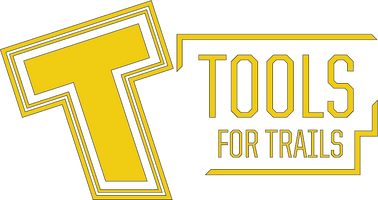How to Cut Trail Corridor


Whether you're a professional trail builder, crew lead, or volunteer, properly identifying which trees to remove from your trail corridor is both a science and an art. Done with care and intention, your trail will appear as if it was sculpted by mother nature herself. Done haphazardly, it will look like a four-lane highway.
In this post, we’ll explain why the trail corridor is important, how to efficiently select trees for removal from the corridor, and tips for avoiding common mistakes.
What is a Trail Corridor, and Why Does it Matter?
Trail corridor is the area that encompasses the trail tread as well as the immediate areas to the sides and above the trail. Obstacles within the corridor, such as trees, are trimmed or removed altogether so that it is possible for a trail user to pass.
Properly managing the corridor of your trail project is an important but often overlooked aspect of trail construction and design. By paying attention to your corridor and how it affects the use of your trail, you’ll not only leave a smaller impact on the land, but your efforts will also create a better overall experience for your trail users.
5 Tips For Creating a Better Corridor
1. Don't Flush Cut Trees Inside the Corridor
As your corridor crew moves ahead of the rest of the team, they may be tempted to flush cut trees to the ground along the flag line. This presents a problem if the trail needs to change direction and you must remove a flush cut stump. The lack of leverage to aid in removing the stump makes the process increasingly difficult.

Instead of flush cutting, make your cut three to four feet above the root system. This height is sufficient enough to secure a winch cable or other mechanical system to the remaining trunk to aid in pulling out the tree. This height also enables you to take a Pulaski to the roots to help release it. It's a battle to cut roots on a stump otherwise, but with the added tension of a winch, the roots practically explode when hit. It’s also wise to cut a small notch into the trunk with a saw on slippery wood such as aspen or fir. It gives a groove to keep your winch strap from slipping.
2. A Discernible Eye is Important
Walk the flag line and constantly look at it from both sides. Try to look at the natural contours of the land and look for the most obvious path. Flag lines often seem straight and it's your job to add the curvature that makes the trail have an intimate feel. These curves are naturally in the land and your line choices will help accentuate the natural flow. The canvas is laid out by the Sawyer!

While efficiency is certainly important, haphazardly hacking through the corridor causes much more work in the end. We have a saying in the climbing world. Slow is smooth. Smooth is fast. Regarding large trees, ask yourself, does it even need to be taken?
- Can you get the trail, or machine through these two trees?
- Does it make sense to bring the line above or below the trees?
- If you have to take a tree, which one? Should you take both? Probably not.
As a rule, we’ll typically take only one. Usually, the smaller one for obvious reasons, unless the larger tree is dead, diseased or it's absolutely necessary. If you take two trees 4' apart you may end up with a 10' corridor. Do it for a long stretch and your corridor will look like a superhighway. If you’re on the fence about taking out a tree then leave it. You can always cut it later if necessary.
Your goal is to sneak through the woods with as light a hand as possible.
3. Trees Needing Removal Outside the Trail Corridor Should be Flush Cut
A great example of this is mahogany that is mostly out of the way but tends to overhang the corridor. Take the time to flush cut what needs to go. It's extra work, but exposed stumps are a trail hazard and their appearance degrades the experience. Limbs should also be sawed back to the node. Nobody likes being impaled when they miss a turn and strike a tree.

Flush cut trees outside the corridor to avoid creating trail hazards
4. Address Downed and Snagged Trees
Downed trees over your trail should be sawed on either side of the trail with cuts being made on each side of your corridor. Also, be on the lookout for trees that have fallen but are snagged on healthier trees above your corridor. All it takes is a strong wind event to bring that tree down on your trail or worse, a trail user. Take care of it now.

Snagged trees should be taken care of before they become a problem
5. Move Cuttings Away from the Trail and Out of Sight
The Sawyer and or swamper should get the cuttings well away from the trail and ideally stashed out of sight. Piled along the side of the trail is difficult to deal with once a machine has covered them with dirt. This is another reason to be conservative with your cuts. Less is more!

Leave no trace and move cuttings well away from the trail
Summary
Cutting trail corridor is often overlooked during a trail building project, but paying attention to the details will save you time, money and headaches by not having to go back and fix mistakes. If you find yourself agonizing over which trees need to come out for you to proceed, take a step back, remember our tips, and trust your gut.
Now that you’ve learned how to cut trail corridor more efficiently, make sure you’ve got the right tools to do so. We carry everything you need from chainsaw protective equipment to Pulaskis, handsaws, and more.




Comments